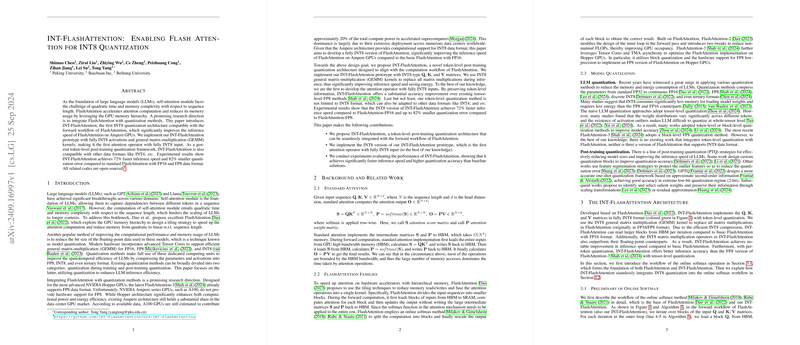INT-FlashAttention: Enabling Flash Attention for INT8 Quantization
The paper titled "INT-FlashAttention: Enabling Flash Attention for INT8 Quantization" focuses on integrating INT8 quantization with FlashAttention to enhance the inference speed and accuracy of LLMs. The authors introduce a novel architecture, INT-FlashAttention, specifically designed for Ampere GPUs, which lack support for the FP8 data format integral to newer Hopper GPUs.
Background
LLMs like GPT and Llama leverage self-attention mechanisms to capture dependencies within sequences. However, the computational intricacies of self-attention involve quadratic time and memory complexity, which complicates application to longer sequences. FlashAttention addresses this by utilizing a tiling strategy and the GPU memory hierarchy to optimize memory usage, reducing it from quadratic to linear w.r.t. sequence length.
Quantization further enhances LLM performance by reducing the bit size of data formats, thereby minimizing memory usage and computational demands. Current hardware supports various formats, including FP16, FP8, and INT8, with quantization techniques broadly categorized into training-phase and post-training approaches. This paper's focus on post-training quantization aims to make FlashAttention feasible for INT8 data formats, particularly on Ampere GPUs.
INT-FlashAttention Architecture
INT-FlashAttention expands FlashAttention’s capabilities by implementing fully INT8 quantized matrices – Query (Q), Key (K), and Value (V) – and using INT8 general matrix-multiplication (GEMM) kernels. Employing a token-level quantization strategy enhances speed and accuracy compared to traditional tensor-level methods.
The framework maintains INT8 quantized inputs stored in high-bandwidth memory (HBM). During the forward pass, the INT8 GEMM operations are employed, preserving token-level information and leveraging integer operations to ensure computational efficiency. Key matrices are scaled adaptively using predefined scalers, allowing precise and computationally efficient updates within the INT8 domain. The architecture’s integration into the FlashAttention workflow manifests in considerable empirical performance enhancements.
Experimental Results
The authors conducted performance evaluations on an NVIDIA RTX4090 GPU, contrasting INT-FlashAttention against FlashAttention implemented with FP16 and FP8 formats.
Inference Speed:
- INT-FlashAttention demonstrated a 72% improvement in inference speed over FlashAttention with FP16 data and comparable performance to FP8 data format FlashAttention.
Quantization Accuracy:
- By evaluating mean relative error (MRE), INT-FlashAttention showed significant error reductions. Specifically, it achieved 46% and 82% smaller quantization errors under normal and uniform distributions of activations, respectively, compared to FP8 FlashAttention.
Implications and Future Directions
The introduction of INT-FlashAttention presents several implications for future research and practical deployment:
- Efficiency in Data Centers: INT-FlashAttention’s compatibility with the prevalent Ampere GPUs offers immediate benefits in terms of computational efficiency and energy usage, pertinent for large-scale deployments in data centers.
- Enhanced Model Scaling: The reductions in memory and computational requirements facilitate the scaling of LLMs to longer sequences, potentially improving the robustness and versatility of such models in real-world applications.
- Future Research: Future work includes refining the quantization of the V matrix on a per-block, instead of a tensor-level, basis. This may further enhance accuracy and harness additional computational savings. Additionally, combining INT-FlashAttention with Hadamard transformations could open new avenues for optimizing inference processes.
- Open-Source Contribution: The open-sourcing of the codebase ensures transparency and encourages further innovation within the research community, fostering collaborative improvement and adaptation of the INT-FlashAttention architecture.
Conclusion
INT-FlashAttention represents a significant methodological advance in enhancing the inference efficiency and accuracy of LLMs, particularly tailored for INT8 quantization on Ampere GPUs. Its adoption could lead to more efficient large-scale AI implementations, with significant theoretical and practical implications for the future of AI research and deployment.
